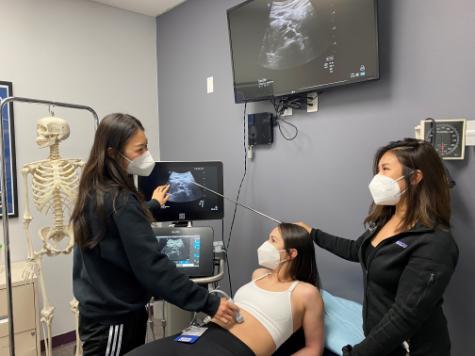Ultrasound Training
Touro students aid with ultrasound training

Most people are probably familiar with the idea of ultrasound imaging providing a somewhat grainy glimpse of an unborn child to expecting, anxious parents. Ultrasound imaging, however, is being employed to a greater and greater extent to give physicians a look at more than just bundles of joy, including potentially life-threatening conditions that may require quick intervention.
Book excerpts and lectures can teach a certain amount to physicians and student physicians, but with ultrasound, the best learning is literally hands on.
Dr. Sally Graglia, an emergency medicine physician at San Francisco General Hospital (SFGH) and faculty member at University of California, San Francisco (UCSF), helps guide point-of-contact ultrasound (POCUS) training for both students and physicians.
“To truly gain the confidence necessary to perform POCUS studies and ultrasound-guided procedures, you must use your hands,” Dr. Graglia said. “You must hold the ultrasound probe in your hands and see the image move as you move your probe. You must build that muscle memory.”
And unlike CPR training, which can be accomplished with the use of a mannequin, ultrasound training is effective through the use of living, breathing models.
Enter: Jori Enfield, a Student-Doctor at Touro University California. Enfield knew Dr. Graglia for a previous position working at SFGH and, once he enrolled at Touro, helped recruit fellow College of Osteopathic Medicine students to serve as models.
“At some point, he really stepped up and took ownership of coordinating models for the various educational opportunities of which I was a part,” Dr. Graglia said.
Dr. Graglia’s own students gained from having the Touro models for pragmatic purposes, but the groups of students were also able to exchange their ideas and philosophies related to MD and DO training with one another, as well.
“Shortly after beginning my first year at TUCOM, Dr. Graglia provided an opportunity to share the world of POCUS with my classmates,” Enfield said. Both PA and COM students took part in the training. “We had a phenomenal experience, and I personally enjoyed networking, deepening my learning, and expanding my perspective of medicine.”
First-year medical students Jennifer Addleman and Sallie Canumay were also among the group of students helping with the training.
“Ultrasound is a skill that is acquired only by hours of learning and hands-on practice,” Addleman said. “Visiting UCSF and learning from Dr. Graglia has been a fantastic opportunity to learn about point of care ultrasound and how it can be applied to fields I am interested in.”
“POCUS volunteering at UCSF has been such an incredible opportunity for TUCOM students,” It’s not only given me the chance to learn more about POCUS, but also to interact with different physicians and medical students at UCSF.”
The sessions weren’t just a one-and-done offering, either. Future sessions have been planned and Touro students are expected to continue providing models.
 “With future events scheduled, my hope is that opportunity continues to expand for Touro. I am excited to see what doors open for us next,” Enfield said.
“With future events scheduled, my hope is that opportunity continues to expand for Touro. I am excited to see what doors open for us next,” Enfield said.
“I am interested in sports medicine, so musculoskeletal radiology is an integral part of the field and my interest,” Addelman said. I believe the more time I spend working with ultrasound, the better I can get at it. Learning from Dr. Graglia has been a great opportunity to do so.”
Dr. Graglia is an educator at heart, so she’s been pleased the experience has been positive for both groups of students.
“Working with the Touro students has been an absolute joy,” Dr. Graglia said. “The Touro students and ultrasound leadership have been enthusiastic, engaged, committed, and see the utility of ultrasound in their future careers.”
She added, “As an educator, I want every student to walk away from an educational session with a sense that they gained something, no matter their role. I hope that the Touro students have benefited from being in advanced ultrasound sessions targeting Emergency Medicine residents and faculty.”
